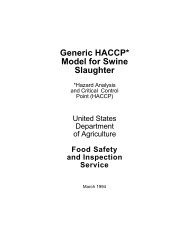Generic HACCP Model for Thermally Processed Commercial
Generic HACCP Model for Thermally Processed Commercial
Generic HACCP Model for Thermally Processed Commercial
Create successful ePaper yourself
Turn your PDF publications into a flip-book with our unique Google optimized e-Paper software.
HAZARD ANALYSIS/PREVENTIVE MEASURES<br />
PROCESS CATEGORY: THERMALLY PROCESSED, COMMERCIALLY STERILE<br />
PRODUCT EXAMPLE: PASTA SAUCE WITH MEAT<br />
Process Step<br />
STORAGE -<br />
MEAT<br />
STORAGE -<br />
NON-MEAT<br />
STORAGE -<br />
PACKAGING<br />
PREPARATION -<br />
MEAT<br />
PREPARATION -<br />
NON-MEAT<br />
HAZARDS<br />
Biological (B) Including<br />
Microbiological<br />
Chemical ( C)<br />
Physical (P)<br />
B- inadequate storage temperatures<br />
could result in pathogen proliferation<br />
B-No significant hazards identified<br />
P-(Hazardous Foreign Material)<br />
low risk<br />
low significance<br />
low risk<br />
no significant hazardous<br />
B-inadequate pH of tomatoes could<br />
result in insufficient acidification to<br />
assure product safety.<br />
P-no significant hazardous<br />
low risk<br />
JAR CLEANING P-Hazardous Foreign Material remains<br />
after wash cycle.<br />
Meat and Poultry Products Hazards and<br />
Control Guide<br />
FORMULATION B-If processing authority’s maximum pH<br />
recommendation is exceeded, the thermal<br />
process may be inadequate.<br />
FILLING B-If fill temperatures less than<br />
processing authority’s recommendation,<br />
the thermal process may be inadequate.<br />
SEALING None identified<br />
THERMAL<br />
PROCESSING<br />
LABELING &<br />
CASING<br />
B-Improper application of the thermal<br />
process may not provide sufficient<br />
lethality to achieve shelf stable stability.<br />
N/A low risk, severity<br />
STORAGE N/A low risk, severity<br />
SHIPPING N/A low risk, severity<br />
* Not to be included in a plant specific <strong>HACCP</strong> plan.<br />
46<br />
Preventive Measures<br />
Routine refrigeration<br />
maintenance. Monitor<br />
product temperature<br />
Visual inspection of nonmeat<br />
ingredients prior to<br />
preparation.<br />
Monitor pH of all batches of<br />
crushed tomatos added at<br />
time of preparation.<br />
Examples of How Hazard Is<br />
Introduced *<br />
B-Excessive boxed product is<br />
stored exceeding cooler capacity<br />
and temperature of boxed product<br />
rises above 50 F <strong>for</strong> two days.<br />
Wood, metal, or glass may get in<br />
product if stored in open containers<br />
or during manufacture.<br />
B-Supplier controls of storage<br />
conditions alter the pH of<br />
ingredient.<br />
Cleaning operation P-Foreign material present at<br />
receiving plus any resulting from<br />
subsequent storage and handling.<br />
Control of pH during<br />
<strong>for</strong>mulation confirmed by<br />
finished product pH testing.<br />
B-Inadequate pH control of meat or<br />
tomatoes during thermal process<br />
results in a pH >4.5.<br />
Fill temperature control. B-Fill temperature is not<br />
maintained high enough to meet<br />
process schedule requirements.<br />
Operational thermal<br />
processing controls.<br />
B-During a hot fill and hold<br />
process, closing and/or holding<br />
temperatures or holding times are<br />
less than specified in the process.



